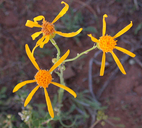Taxon Report
Packera layneae (Greene) W.A. Weber & A. LoveLayne's ragwort |
 Steve Tyron |
Taxon Summary
Packera layneae, commonly known as Layne's ragwort, is a perennial herb in the Asteraceae that is found only in California. It occurs within Chaparral, and Cismontane woodland, growing at elevations from 200 to 1085 meters. Packera layneae is ranked 1B.2, Plants Rare, Threatened or Endangered in California and Elsewhere; Moderately threatened in California.Classification
|
Scientific Name: |
Packera layneae (Greene) W.A. Weber & A. Love |
|
Common Name: |
Layne's ragwort |
| Family: | Asteraceae |
| Element Code: | PDAST8H1V0 |
| USDA Plants Symbol: | PALA41 |
|
Synonyms/Other Names: |
|
Ecology and Life History
| Lifeform: | perennial herb |
| Blooming Period: Apr-Aug | Apr-Aug |
| Elevation: | 200-1085 (655-3560) |
| General Habitats: | Chaparral, Cismontane woodland |
| Microhabitat: | Gabbroic (sometimes), Rocky, Serpentine (sometimes) |
| Microhabitat Details: |
Conservation Status
| CA Rare Plant Rank: | 1B.2 |
| Global Rank: | G2 |
|
State Rank: |
S2 |
| State List: | CR |
| Fed List: | FT |
| Other Status: | SB_CalBG/RSABG; SB_UCBG; SB_UCSC |
|
CRPR Changes: |
|
Occurrence Data from the CNDDB
| Total Occurrences: | 48 |
| Element Occurrence Ranks: | |
| Excellent (A) | 2 |
| Good (B) | 19 |
| Fair (C) | 6 |
| Poor (D) | 4 |
| None (X) | 2 |
| Unknown (U) | 15 |
| California Endemic: True | |
| California Counties and Islands: Name (Code) | |
| El Dorado (ELD), Placer (PLA), Tuolumne (TUO), Yuba (YUB) | |
| Quads: Name (Quad Code) | |
| Chinese Camp (3712074), Clarksville (3812161), Coloma (3812078), Dutch Flat (3912027), Foresthill (3912017), Garden Valley (3812077), Georgetown (3812087), Moccasin (3712073), Pilot Hill (3812171), Placerville (3812067), Rackerby (3912143), Shingle Springs (3812068) | |
Threat List Data from the CNDDB
| Threat List Total: | 18 | |
| EOs with Threat Listed: | Total EOs | % of EOs |
| 32 | 67 % | |
| Development | 16 | 33% |
| Road/trail construction/maint. | 14 | 29% |
| ORV activity | 6 | 12% |
| Other | 6 | 12% |
| Mining | 4 | 8% |
| Recreational use (non-ORV) | 4 | 8% |
| Erosion/runoff | 4 | 8% |
| Grazing | 3 | 6% |
| Vandalism/dumping/litter | 3 | 6% |
| Non-native plant impacts | 3 | 6% |
| Logging | 2 | 4% |
| Biocides | 2 | 4% |
| Dam/Inundation | 1 | 2% |
| Disking | 1 | 2% |
| Agriculture | 1 | 2% |
| Landfill | 1 | 2% |
| Pollution | 1 | 2% |
| Wood cutting or brush clearing | 1 | 2% |
Notes
|
|
|
Threats: |
| Threatened by urbanization, development, clearing, grazing, road construction, vehicles, non-native plants, and fire suppression. |
|
Taxonomy: |
| See Senecio layneae in TJM (1993). See Bulletin of the Torrey Botanical Club 10:87 (1883) for original description and Phytologia 49(1): 44-50 (1981) for revised nomenclature. |
Citation
California Native Plant Society, Rare Plant Program. 2025. Rare Plant Inventory (online edition, v9.5.1). Website https://www.rareplants.cnps.org [accessed 17 December 2025].